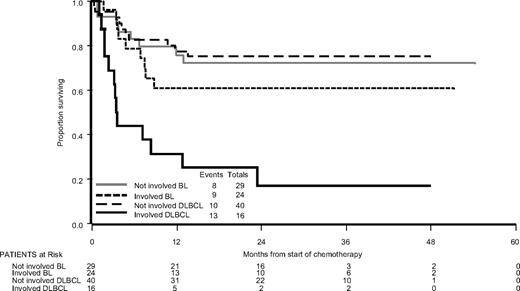Response:
Professor Yin and his colleagues at Manchester describe a series of 13 patients with aggressive B-cell lymphomas with bone marrow involvement who had a very poor outcome despite intensive treatment including allogeneic transplantation in 3 cases. In all of the tumors a MYC rearrangement was present, but in most cases this was in the context of a complex karyotype and in 4 of the patients a t(14;18) was also present.
The experience of the Manchester group serves to highlight the key point that emerged from the analysis of the MRC LY10 trial, which is that the effective targeting of intensive chemotherapy such as CODOX-M/IVAC in aggressive B-cell lymphomas requires a strict pathologic definition of Burkitt lymphoma.1 In LY10 we proposed criteria based on germinal center phenotype, lacking BCL-2 expression, with a MYC rearrangement as the sole genetic abnormality. Although there are clearly gray areas, this approach is supported by published gene expression data and by other studies reporting the very poor clinical outcomes for B-cell lymphomas with complex cytogenetics, particularly where multiple balanced translocations are present.2-4 When this definition is used, the data from LY10 shows that bone marrow involvement at presentation had only a small effect on outcome. 24/53 patients in the trial had marrow involvement and this group had a 2-year overall survival of 61.0% (95% confidence interval [CI] 41.0%-80.9%) compared with 72.1% (95% CI 55.7%-88.5%) for those with no marrow disease (Figure 1). Conversely, in the 16/56 DLBCL patients with marrow involvement, 2-year survival was only 16.7% (95% CI 0.1%-36.1%) compared with 75.0% (95% CI 61.6%-88.4%) in those with no marrow disease. It is possible that these results may be further improved by the addition of rituximab, although trial data are lacking. The published series treated with hyper-CVAD rituximab appear to relate to a heterogeneous group of patients of which only one-third had a MYC rearrangement.5
Using the current edition of the WHO classification, it is likely that most of the cases in the Manchester series would be placed in the category “B-cell lymphoma, unclassifiable, with features intermediate between diffuse large B-cell and Burkitt Lymphoma” rather than “Burkitt Lymphoma.”6 The justification for this new category is the recognition that these tumors are frequently refractory to chemotherapy and have short survival. As the data from LY10 shows, the accurate distinction between this group and Burkitt lymphoma is clearly important given the sharply contrasting responses to chemotherapy. The techniques used to make this distinction are likely to improve with the introduction of gene expression profiling and whole genome genotyping based on SNP arrays and array CGH. However, the key question will remain how to manage patients who are identified at presentation as having disease that is likely to be refractory to chemotherapy.
Authorship
Conflict-of-interest disclosure: The authors declare no competing financial interests.
Correspondence: Wendi Qian, MRC Clinical Trials Unit, 222 Euston Rd, London NW1 2DA, United Kingdom; e-mail: wendi.qian@ctu.mrc.ac.uk.



